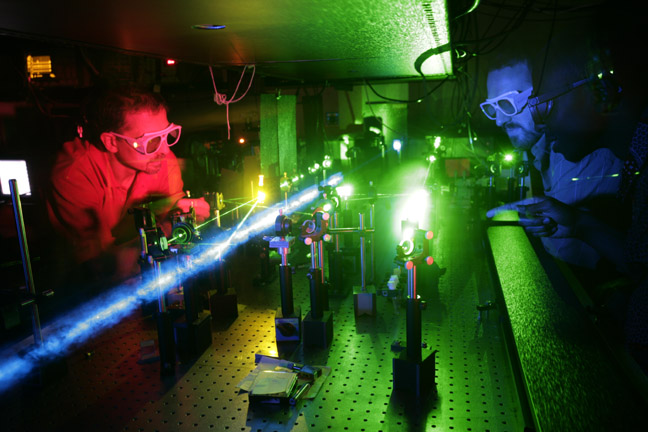
In the laser lab in the next building over, my colleagues face lighting challenges. Much of the experimenting needs to be done in darkness, but the setting up and adjustment of lenses, beam splitters, laser cavities, vacuum systems, cooling pipes, and the rest requires nice strong light to handle the delicate, fiddly parts. The trouble is that most of the material in the room, including the optical table everything is mounted on, is made of reflective metal. Having good, bright lighting that lets you see everything, and isn’t going to cause strong reflections on most of your surfaces--which make it harder to see fine details—is tricky. You don’t even have the luxury of being able to light from directly above, because of the racks of equipment feeding power cables and electronic signals and sensors down to the optical table. When working in the dark, these physicists have gotten used to looking at certain things from the corners of their eyes, where the cells are more susceptible to dim lights, even though it’s at the expense of color vision. Looking right at something is the best way to make it disappear in a dark room, and even though they’re physicists, that has nothing to do with Schrodinger’s cat—it’s just a function of biology.

On another part of campus, a friend is studying photoautotrophism. In this instance, her photosynthetic bacteria need both the environment of a sterile lab for replicability and a source of light that mimics sunshine. Fortunately, there is a whole range of lightbulbs that give different variants of daylight spectra suitable for the purpose. There is a market for lightbulb with exotic spectra for uses in science labs, but also in spinoff applications for experimental photography.

And then the geologists I have ventured underground with have a whole extra sense of dark. Exploring caves more than one kilometer underground, the sense of dark is complete when everybody turns off their headlamps. It’s a bewildering feeling at first, and it almost inspires a kind of agoraphobia, because the darkness removes the walls from sight and, at the edges of your mind, from existence. A guy I knew once freaked out in a huge underground cavern in Thailand because his light, through strong, wouldn’t let him see as far as any walls in any direction. He might as well have been in a vast desert with nothing appearing in his sight lines no matter which horizon he faced. Lost in space with no reference points except up and down. Deep underground the dark plays with your sense of scale and space that agoraphobia, astrophobia, and a bunch of other fears, not the least of which involves running out of power for your lights and being trapped unable to find an exit, are common and heightened.
The archaeologists take a break in the noon-time hours and early afternoon because, although the light is good, and just what their predecessors needed most when exploring ancient ruins, it brings with it a heat that makes working unbearable.
An astronomer sits in brightly lit control rooms with all his computer terminals at hand, the coffee pot lamp blinking in the corner, having slept and waited through the daylight and for the clouds to clear so that his telescope has unimpeded dark above it. He needs the dark to spot the lights that takes him back in time to the early days of the universe.
Meanwhile, in another part of the world, the mathematician scribbles on a pad of lined paper illuminated by a warm sunshine pouring in the window, at least until the dark arrives, when she switches on a desk lamp to fight back the dusk for just a few more hours.




No comments:
Post a Comment